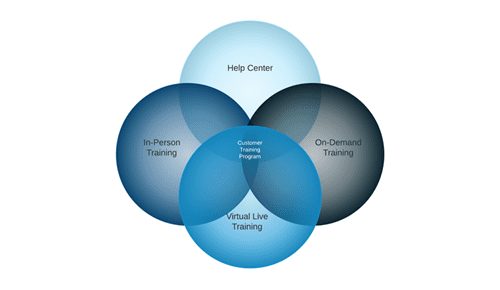At Skilljar, we work with many companies that use online course delivery to improve their customer training. Your company’s success is based on your customers’ success and satisfaction. Whether you’re a software company, a fitness brand, or any industry in between, there are methods of customer training that can benefit your customer, and your company’s long-term sustainability. For companies that are still developing their customer training strategy, it can be overwhelming to sift through all the different options being used today.In this article, we take a look at the four methods of customer training. A customer training program is comprised of at least one of these methods, and most common is using a combination. Different methods are more relevant to certain industries or to specific stages of a company - which ones are right for you?Or, if you're looking for a more in depth guide on customer training and education check out our complete guide on www.skilljar.com/customer-education/.1. Help CenterMany companies that we work with have a basic help center, resource library, or knowledge bank in place. The more extensive help centers serve as both marketing and customer support functions. The resources are typically freely available (no registration required) and include:
- Help articles
- Videos
- White papers
- User forums
Help centers are relatively easy to produce and maintain. However, the materials are passive (without feedback in either direction) and can become difficult to use as more content is added.2. On-Demand TrainingOn-demand (or ‘self-paced’) training is increasingly popular, due to a globally distributed workforce, 24/7 access, and improvements in streaming video technology. Typical segments are short (less than 15 minutes) and targeted to customers with specific questions. By requiring registration, the structured course format gives the customer the convenience of both tracking their progress and following a specific learning path.While you do need to invest time in creating content, the ongoing maintenance is relatively low. Another advantage of requiring customer registration is seeing the analytics of how they are using and engaging with your content. We’ve seen Skilljar clients implement both free and paid training classes with great effectiveness.3. Virtual Live TrainingTo get live feedback from potential and existing customers, consider offering live webinars using technologies like WebEx, GoToMeeting, Adobe Connect, and Livestream. These sessions typically require registration, so you have a record of who attended for CRM purposes. Live events can be effective for generating special interest, and for those customers who prefer scheduled sessions. These programs often offer features which enable remote classrooms and screen sharing.However, instructor-led online events don’t address customers who need the information right away, or cannot make the webinars due to timezone or scheduling conflicts. You also need to staff a live instructor for each event. This carries a personnel cost, but is still more affordable than in-person training. You can also decide whether to charge for the sessions as part of a premium support offering.4. In-Person TrainingIn-person (or ‘on-site’) training is the most traditional form of education. In-person classes are more customizable to your customers’ needs and often include customer-specific scenarios and hands-on exercises to reinforce learning. It is also the least scalable. This is the most costly of the four elements described above, but customers also have a higher willingness to pay.

Building your Customer Training Strategy
Ultimately, your customer training program will include one or more of the methods above. Some companies may incorporate all four elements, and even offer certification programs. Two great examples of companies utilizing all four methods are Tableau Software and Workday.Should you include all four elements in your customer training strategy? Consider how your customers prefer to learn, and what your capabilities are in terms of technology, staffing and budget. As your business grows, you will likely add and modify components to address different needs.For more information, check out our comprehensive online guide to Customer Education.
Read more blog posts
Ready to take Skilljar for a spin?
Take an interactive tour of Skilljar, or book your demo with our team.
